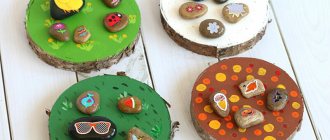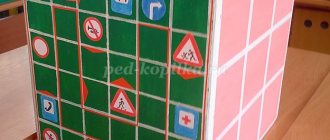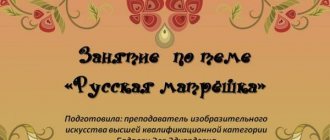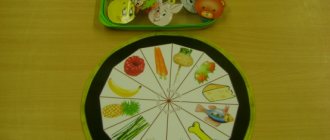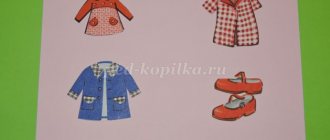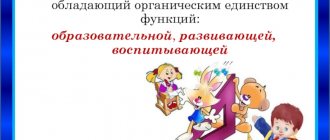Didactic game for children 3-7 years old. Funny Matryoshkas
Didactic game for preschoolers
Purpose: To develop attention, thinking, imagination. Material: sheets of white paper, cardboard: yellow, red, green; pva glue, scissors, watercolor, brush, varnish. Making: I drew thirty nesting dolls - fifteen pairs. Decorated with watercolors. Every ten nesting dolls were glued onto cardboard of a different color: yellow, red, green. Cut it out. Then I coated it with varnish. Didactic game "Funny Matryoshkas" - a universal game. Children 3-7 years old can play it, just like during classes. and in your free time. A cheerful toy - a painted matryoshka - was born 100 years ago. It was invented by the artist Sergei Vasilyevich Malyutin. Among the Japanese children, he saw a toy - the old sage Daruma. It was a tumbler toy. Inside it was another similar Daruma doll, only smaller. And the artist invented a doll for Russian children that looked like the Japanese Daruma. And the doll was unusual, with a wonderful surprise: inside each doll sat a smaller doll, and in that one an even smaller one, and another, and another... (Shows the nesting doll.) S.V. Malyutin dressed each doll in a painted sundress, a bright scarf and a colorful apron. And they called this doll Matresha, an old Russian name, after a kind, beautiful girl who worked in the artist’s house. This is how the matryoshka doll was born - a detachable wooden doll. The most suitable material is dry linden or birch, as it is very soft and can be easily cut with a knife. Wood blanks were sanded and then painted by artists. I offer several options. Option 1. Find a mate for each matryoshka.
Option 2 . Find 2 identical nesting dolls.
Option 3. Find differences. From two nesting dolls:
From three nesting dolls:
etc. Option 4. Fix the names of the colors: yellow, red, green.
There are many more options for using “Merry Matryoshka” during game programs
We recommend watching:
Didactic games for children of the first junior group Didactic games with buttons for children 3-4 years old Educational games with Dienesha blocks in the junior group Do-it-yourself didactic manual “Draw paths” for the junior group
Similar articles:
Didactic games on physical development in the 2nd junior group of preschool educational institutions
Methods of using didactic games in kindergarten in the junior - middle group
Didactic games for developing the abilities of preschoolers 3-5 years old to identify the properties of objects
Didactic game for children 4-7 years old “Fairytale Hotel”
Game layout for children 4-7 years old “My City”
so UNT / Preschool education / Games in kindergarten
WHAT CHANGED? (GAME WITH NESTING DOllS)
06.04.2013 5385 0
WHAT CHANGED? (GAME WITH NESTING DOllS)
Didactic task.
Exercise children in correctly naming objects and their actions (the nesting doll hid, came running, stands still), notice and name the difference in the color of clothing and the size of the nesting dolls, cultivate in children visual memory, voluntary memorization, observation, and speech.
Game rule.
Only the one who is called matryoshka-mama (the largest nesting doll) answers.
Game action.
Guessing what has changed in the arrangement of the nesting dolls.
Progress of the game.
The teacher shows the children one by one five different-sized multi-colored nesting dolls. The children look at them. All nesting dolls are different in size and are dressed in different sundresses and scarves (see color insert). Together with the children, the teacher names the colors of clothes and notes that all nesting dolls are different in size.
Children sit at a table in a semicircle; it is placed so that everyone can see the nesting dolls standing on the teacher’s table.
The teacher asks a question:
- Children, what do you see on my table?
“Matryoshka dolls,” the children answer in unison.
Look at the height of the nesting dolls. (Places two, then three, and then four nesting dolls next to each other.) Are they the same height or not? (“Different.”) What is different about them? Look carefully!
At first, the children find it difficult to answer correctly, the teacher helps them with leading questions:
- Look at the handkerchiefs. What are they? (Touches first one, then another nesting doll.) That's right. One nesting doll has a red scarf, another has a green one, and this one has a blue one. How can we say about handkerchiefs in one word? (“The nesting dolls have handkerchiefs of different colors.”) And sundresses? How can you say? Right. Their sundresses are also different. (Together with the children, name the color of each nesting doll’s sundress: red, green, blue.) Look at them and remember how the nesting dolls are dressed.
Now let’s play like this: I’ll cover the matryoshka dolls with a screen, and then you’ll find out which doll will hide. But you need to answer only one at a time, so the one who notices will come up to me and say quietly so that others do not hear.
Next, the teacher draws the children’s attention to the size of the nesting dolls: he hides behind the screen first one, then another, then two at once.
When the game is played again, the one the matryoshka points to answers.
You can use other items in the game, depending on what tasks are being solved.
, games
Rules for children's game with matryoshka
Role-playing games with matryoshka dolls in kindergarten are carried out with preliminary preparation, and different variations are used. Initially, with the help of wooden toys, spatial concepts are practiced - “big” - “small”, because when assembling a nesting doll, these conditions must be adhered to. You can offer children the game “Hide the Matryoshka”. What does it mean? One of the participants turns away, while the others hide one of the nesting dolls. The goal of the game is to guess which toy has disappeared.
There is another option - playing with a matryoshka doll in kindergarten “Dress Up”. Children are given sheets of paper and they draw a new sundress and scarf for a wooden toy. The work is creative and requires a preliminary story about Slavic traditions and “talking” ornaments. It is believed that playing with matryoshka dolls in kindergarten contributes to the development of aesthetic taste.
The final stage of any game is a discussion of the beauty of a wooden toy, composing fairy tales where the main characters are nesting dolls, small and large. The usual names for playing with matryoshka dolls in kindergarten are “The Adventure of Mother and Daughters.”
Travel game “Russian nesting doll”
(middle group)
Target:
- to form children’s ideas about the Russian nesting doll as one of the ancient folk crafts;
— continue to enrich children’s understanding of folk art;
- develop aesthetic perception of folk art objects;
— develop the need and ability to independently master the world around us by studying cultural heritage;
- develop visual memory, thinking, spatial imagination, perception of size and counting;
— to develop children’s ability to write short descriptive stories; enrich vocabulary
- develop the ability to participate in joint games;
- cultivate independence and activity.
Equipment: nesting dolls, envelopes with cut-out pictures.
Progress of the game
Educator: Children, let's play with you? Today we will go on a journey. But we will not travel alone, but with our guests. (Music sounds, a matryoshka doll comes out). Guys, this is our main guest! Let's say hello and wish each other good health.
Who came to us? How do you think? (children's answers).
Matryoshka:
A scarlet silk scarf, a bright sundress with flowers, a hand resting on the wooden sides. And there are secrets inside: Maybe three, or maybe six. I got a little flushed. This is Russian...
Children: Matryoshka!
Educator: Well done, guys! Our traditional toy, the nesting doll, is known not only in our country, Russia, but also far beyond its borders. Not only do children all over the world play with matryoshka dolls, but people also give them to each other as a souvenir - a small gift from Russia. To make a nesting doll, a tree is used - birch or linden. The figurine is then processed and painted into two parts, painted, decorated and varnished.
Matryoshka: Guys, today we have a trip to the Russian nesting doll museum. Do you want to see a lot of interesting things? Let's hit the road!
Music is playing
P/i "Train"
Children line up one after another, holding onto the belt of the child in front. Each child is a carriage, and the one standing in front is a locomotive.
Educator: Guys, we have arrived at the museum of Russian craftsmen. What do you see here (matryoshka dolls), and what is a matryoshka doll? (toy) What are they made of? (It's made of wood) That's right! The figurine is disassembled into 2 parts, and in it there is another figurine, similar to the first, only a little smaller, and in it there is also another... (The teacher takes apart the nesting dolls.) Look, all the nesting dolls are mixed up.
D/i “Find the legs of the nesting doll”
Children must assemble the nesting dolls correctly.
Educator: Guys, let's count how many nesting dolls there are (five). Are all the toys the same height? (children's answers)
Matryoshka: Let's look at my outfit. (Children look at the matryoshka doll. Describe it)
Educator: Correct! Our Matryoshka is dressed in a painted sundress, scarf, and apron. Now I will allow you to take one nesting doll from the museum and tell us about your toy. (Children write short descriptive stories).
Educator: Let's put our nesting dolls in place and rest a little.
Game “We are funny Matryoshkas”
Funny nesting dolls, (Clap their hands)
Boots on feet, (Hands on waist, alternately place foot on heel forward)
Variegated sundresses, (Hands on the belt, turns the body to the right - left)
Bright handkerchiefs, (Tilts the head left - right)
We love to dance (Stomping feet)
Our cheeks are flushed, (rub our cheeks)
We are funny nesting dolls,
We look like sisters. (Clap their hands)
Matryoshka: Guys, I have a surprise for you - interesting pictures. You need to collect them.
D/ game “Funny nesting dolls”
Divide the children into teams. Give each team an envelope with a cut-out picture. Task: who can put the picture together correctly?
Matryoshka: What did you do (children’s answers). Well done boys.
Educator: What did we see in the museum?
What is the nesting doll made of?
What is she wearing?
Well done, the nesting doll is our traditional toy, which is known all over the world.
Guys, now let's say goodbye to the guests and invite them back to our kindergarten to play and have fun.
Nimble nesting dolls
The proposed didactic game is recommended for working with children 2-4 years old in order to develop sensorimotor perception.
The game contributes to the formation of concepts and ideas about the life of people, their interaction with each other, and also instills interest in Russian culture through familiarity with folk art. Tasks
:
- To consolidate children's knowledge about the three main colors of the toy - matryoshka (red, yellow, green), knowledge one-many.
- Teach children to build a series in descending and ascending order.
- Learn to examine an object by application, overlay.
- Fix in speech the words “high-low”, “lower”, “lowest”, “above”, “highest”, “big-small”, “biggest”, “smallest”.
- Develop memory, attention, observation.
Materials
: a set of matryoshka dolls made of felt and fabric, inside each doll there is a pocket, in addition - a set of felt balls of appropriate size.
Progress of the game
The teacher shows the children a new toy - a nesting doll (all the nesting dolls are located one inside the other) and asks a riddle: The girlfriends are different in height, But they look alike.
They are all sitting next to each other, and there is only one toy. After this, the teacher lays out nesting dolls in front of the children, gives them the opportunity to examine them, and tries to consolidate the children’s knowledge of “one-many.” Then he draws the children’s attention to how bright, elegant, chubby, and ruddy the matryoshka is. Then you can use different game options.
Mothers are looking for daughters
The teacher shows the children a matryoshka doll and says that this is a matryoshka mother. Shows how you can put a matryoshka doll in your pocket, accompanying the actions with the words: “The matryoshka mother is big, and the daughter is small.” The teacher announces to the children that the nesting doll mothers have lost their daughters and calls on them to help their mothers find them. Children complete the task by placing the daughter doll in the pocket of the mother doll. You can hide all the nesting dolls in one big one.
Where are the girlfriends?
The teacher invites the child to choose any of the 5 nesting dolls, except for the largest one, and asks the children to find matryoshka dolls that are larger than her. The child, by application (or overlay), selects nesting dolls and builds a series series.
Who's hiding?
The teacher says that the nesting dolls went for a walk, but one of them got lost. He asks to look carefully at all the nesting dolls, then closes them, removes one, opens them again and asks: “Which nesting doll is lost?” (Answer options: big, small, red, yellow, green, mother, daughter, etc.)
Round dance
The teacher announces: “Our nesting dolls really love to dance in circles. Let's put them in a round dance." You can turn on a song about a matryoshka doll and dance to the music, do a round dance. After this, the teacher asks for each matryoshka to choose a pair by color, and if there are 2 sets, then by size.
Matryoshka dolls are having lunch
For this option, you need to prepare a set of plates - circles of different sizes - in accordance with the number of nesting dolls. The teacher invites the child to choose a suitable plate for each: the largest one for the tallest nesting doll, a slightly smaller one for the next one, etc. Matryoshka dolls play For this option you will need a set of balls. The teacher offers to play ball with the nesting dolls, but all the balls are mixed up, we need to help the nesting dolls find their balls. Matryoshka dolls and balls are laid out on the table, the child picks up a ball for each doll and puts it in his pocket.
It's time to sleep!
The teacher suggests putting the nesting dolls to sleep.
For the game you will need paper strips or squares of different sizes, corresponding to the size of the nesting dolls. The child chooses cribs for the nesting dolls. Maria Blagushko, educational psychologist, MBDOU “Kindergarten
No. 6 “Firefly”, Gadzhievo, Murmansk region.
